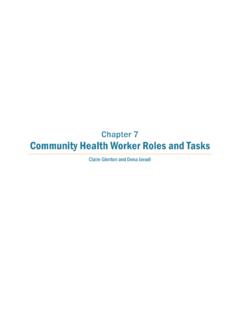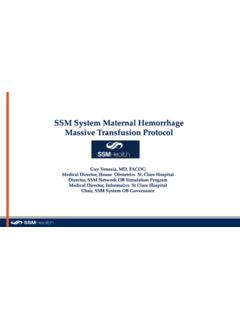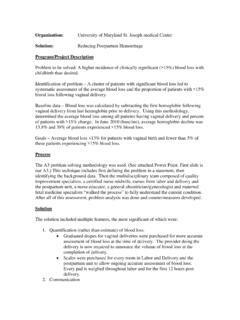Transcription of Maternal Anemia and Blood Loss at Childbirth and ...
1 Maternal Anemia and Blood loss at Childbirth and Postpartum in zanzibar , tanzania mchip nutrition brown Bag March 28, 2013 Justine A. Kavle, PhD, MPH Senior Program Officer for nutrition , mchip Acknowledgements: Ministry of Health, Public Health Laboratory Ivo de Carneri, Mama na Afya study staff in zanzibar , tanzania Dr. Rebecca Stoltzfus, Cornell University, Division of Nutritional Sciences, Dr. Jim Tielsch, Dr. Laura Caulfield, Department of International Health, Johns Hopkins Bloomberg School of Public Health Dr. Frank Witter, Johns Hopkins University, School of Medicine Gates Foundation World Health Organization (WHO) 2 Hemorrhage (PPH) is the leading cause of Maternal death Anemia has been thought to underlie PPH Severe Bleeding34%Other indirect causes 17 %Sepsis10%Obstructed labor 4 %Abortion4%Anemia4%Hypertensive disorders9%Other direct HIV/AIDS6%Khan et al, WHO systematic review 2006 African countries Data is scant on Maternal deaths due to PPH in Africa (Khan, WHO systematic review, 2006) 4 Maternal Anemia is associated with poor birth outcomes, pregnancy complications and death Moderate to severe Maternal Anemia is associated with low birth weight and preterm deliveries Severe Anemia is a cause of Maternal mortality due to.
2 OHeart failure oExcessive Blood loss at delivery Higher Blood loss attributed to impaired uterine muscle strength for labor when prolonged Decreased resistance to infection, as infection may contribute to uterine dysfunction or inertia Decreased uterine Blood flow or low uterine muscle strength may trigger inefficient uterine contractions, mediated by low body iron stores (serum ferritin) and iron deficiency Anemia 6 Proposed biological mechanisms that play a role in PPH Anemia is a plausible pathway Animal model, anecdotal evidence What we know and don t know about Anemia , PPH, and Maternal mortality PPH is the leading cause of Maternal death Yet, most women survive PPH and likely suffer morbidities affecting productivity and care practices, and they may become or remain anemic postpartum Lack of evidence in less developed countries, on the relationship between Maternal Anemia and Blood lost at Childbirth Need for such data in a setting where Maternal mortality and severe Anemia are prevalent We addressed the following unanswered questions: What is the distribution of Blood loss at Childbirth and postpartum in less-developed countries where 99% of Maternal deaths occur?
3 How much do women actually lose? Can a reliable and valid measurement technique be utilized to measure Blood loss at Childbirth and postpartum in a less-developed country? Do women lose more Blood at Childbirth and postpartum in areas where Maternal mortality and severe Anemia are prevalent, as in east Africa? What are the risk factors or determinants for greater Blood loss at Childbirth and postpartum? Is Anemia related? Mothers and Health Mama na Afya community-based trial Prevention and Treatment of Severe Anemia in Pregnancy Population: ~300,000, Muslim Maternal mortality rate:449* Staple foods: rice, cassava P. falciparum malaria and soil-transmitted helminths endemic Study site: Northern Pemba Island, zanzibar * 2008 estimate, Hogan et al, 2010, Lancet Treatment groups: preventing and treating Maternal Anemia Standard of Care Iron folic-acid (60 mg,400 ug), daily Anti-malarial: SP - 2 doses One dose deworming: 500 mg mebendazole Enhanced Care Iron folic-acid, daily Antimalarial: SP 2 doses Two dose deworming: 100 mg mebendazole, twice a day, 3 days Multivitamin (Vitamin A, C, E, B1, B2, B3, B5, B6, B12, folate) 11 Obstetric history Socioeconomic status Maternal morbidity Food Frequency Clinical Exam, treatments Data collection was conducted in ANC clinics and through home visits Pregnancy outcome Infant status Deliver treatments Compliance Birth weight 4 Standard of Care Clinics 4 Enhanced Care Clinics N = 2369 Treatment.
4 Hb < g/dl 1 & 4 weeks post-treatment 32, 36 wks GA, postpartum 34-36 wk venous sample (Hb, Blood loss measurement) 1 Standard of care and 1 Enhanced care clinic N = 268 (Wete town) At delivery and 24 hours: Blood loss sample 2 months postpartum: Hb, Anemia related symptoms Prevention: Hb > g/dl 32, 36 wks GA, PP Mothers and Health study and Blood loss Sub-study (2004-2005) Blood loss sub-study To determine the distribution of Blood loss at Childbirth and 24-hours postpartum, utilizing the alkaline hematin technique Research Aim 1 Diagnosing Blood loss at Childbirth is a challenge due to measurement Health workers rely on visual approximation for deciding if the amount of Blood loss at Childbirth is excessive - 30-50% under-estimation of Blood loss - Can delay diagnosis, referral, and treatment Lack of consensus in research studies No standard definition of excessive Blood loss Cutoff, duration and methods of measurement differ (Brant 1967, Glover 2003) Gold standard for measurement.
5 Alkaline hematin method Alkaline hematin method is the most widely used and most accurate method for objective quantification of Blood loss in women Simple, reliable, practical A few early studies used alkaline hematin to quantify excessive menstrual bleeding and Blood loss at Childbirth and none in developing country settings (Newton 1961, Hallberg, 1964, Chua 1998) Using the gold standard the alkaline hematin method to accurately quantify Blood loss at Childbirth and postpartum 17 Dilute with NaOH Collect pads at Childbirth and postpartum, dilute with NaOH solution Denature hemoglobin in Blood loss to alkaline hematin Measure concentration of alkaline hematin Compute Blood loss at Childbirth At delivery and 24 hours postpartum in Wete Hospital: At > 34 weeks gestational age: Collect venous Blood Measure concentration of alkaline hematin 85% recovery rate 287 ml (97, 579) Graph 3. Total Blood Loss0510152025300-5050-100100-150150-200 200-250250-300300-350350-400400-450450-5 00500-550550-600600-650 Number of WomenBlood loss (mL)Distribution of Blood loss was lower in hospital-based deliveries (N= 158) Kavle, 2006 Why was Blood loss at Childbirth and postpartum lower than expected?
6 No complications of 3rd stage of labor Only two case of prolonged labor (3rd stage > 30 min.) Incidence of PPH low (5%) Breastfeeding following birth is universal Active management of third stage of labor (AMTSL) routinely practiced in hospital-based deliveries 19 Kavle, 2006 Graph 4. Bland-Altman plot of delivery loss measurement methods501001502002503003504004505005506 00-500-450-400-350-300-250-200-150-100-5 0050100150200250300350400450500 Mean + 2 - 2 = - mLDifference in nurses' estimates andlaboratory measurementsNurse-midwives estimated Blood loss accurately, when compared to laboratory measurements, yet had lower precision at higher losses Kavle,2006 Research Aim 2 To evaluate the determinants of Blood loss at Childbirth , and 24- hours postpartum, specifically focusing upon the purported relationship between Maternal Anemia and Blood loss at Childbirth and postpartum Little is known about factors which contribute to excessive Blood loss at Childbirth in less developed countries Nulliparity Grand multiparity Cervical trauma Maternal obesity Maternal Anemia Instrumental delivery Induced labor Prolonged labor Third stage complications Pre- eclampsia Previous history of PPH Birth weight > 4000 grams Geelhoed, 2006, Selo-Ojeme, 1997, Tsu, 1993 Statistical Methods Outcome.
7 Total Blood loss (mL) Childbirth and postpartum Bi-variate analyses Nutritional factors Socioeconomic factors Obstetrical factors Multivariate regression analyses Factors p< in bi-variate analyses Factors identified in previous literature Universal confounders Selected background characteristics Zanzibari women, Wete town (N = 158) Basic characteristics 50th (5th, 95th) or % Age (years) ( - ) Gestational age (weeks) ( - ) Hemoglobin category No Anemia (Hb >110 g/L) Mild Anemia (Hb 90-109 g/L) Moderate to severe Anemia (<90 g/L) Parity 0 1 2-5 >5 Not employed 80% Malarial infection; intestinal helminths Low rate Kavle, 2006 Selected labor and delivery characteristics, Zanzibari women, Wete town (N= 158) Characteristics at Childbirth 50th (5th, 95th) or % Received oxytocin Received ergometrine Received oxytocin and ergometrine Tear Episiotomy Gestational age (weeks) ( ) Birthweight (grams)* 3,410 + 434 Kavle, 2006 * Mean + SD, singleton births only Determinants for total Blood loss : Childbirth and 24-hrs postpartum Independent variable estimate SEM p-value Moderate - severe Anemia vs.
8 No Anemia Mild Anemia vs no Anemia NS First stage of labor (hr) Placental weight (grams) Oxytocin received Pre-term birth < 37 weeks Kavle, 2008 *NS = not significant p > Determinants for total Blood loss : Childbirth and 24-hrs postpartum Independent variable estimate SEM p-value Parity ( 0, Reference) 1 NS 2 - 5 NS > 5 Tear NS Episiotomy NS Standard of Care vs. Enhanced NS Kavle, 2008 *NS = not significant p > Identified Maternal Anemia as determinant of Blood loss , supports hypothesized relationship Strong relationship between Maternal Anemia and Blood loss Influence of Maternal Anemia on Blood loss is more pervasive - affects a normal range of losses Relationships persisted following adjustment of confounding factors Internal validity due to rigorous prospective data collection of women during pregnancy delivery and postpartum Conducted in population where Anemia and iron deficiency are prevalent Study limitations Study sample restricted to semi-urban setting who were able to afford hospital delivery Access to health care may have contributed to lower Blood loss Some loss to follow-up experienced Delivered prior to obtaining venous sample Delivered at home.
9 Could not get to hospital in time Did not stay through 24 hours postpartum Research and programmatic Implications Our findings likely underestimate the effect of Anemia on Blood loss in rural Africa, especially where Anemia is untreated and in home births. Accurate measurement of Blood loss can guide limits for normal Blood loss and excessive Blood loss which may vary by setting Consistency and accuracy of other measurement techniques vs. the gold standard needs further study Further exploration of the link between Maternal Anemia and postpartum hemorrhage Prevention of Anemia is key Thank you (Asante sana)!













